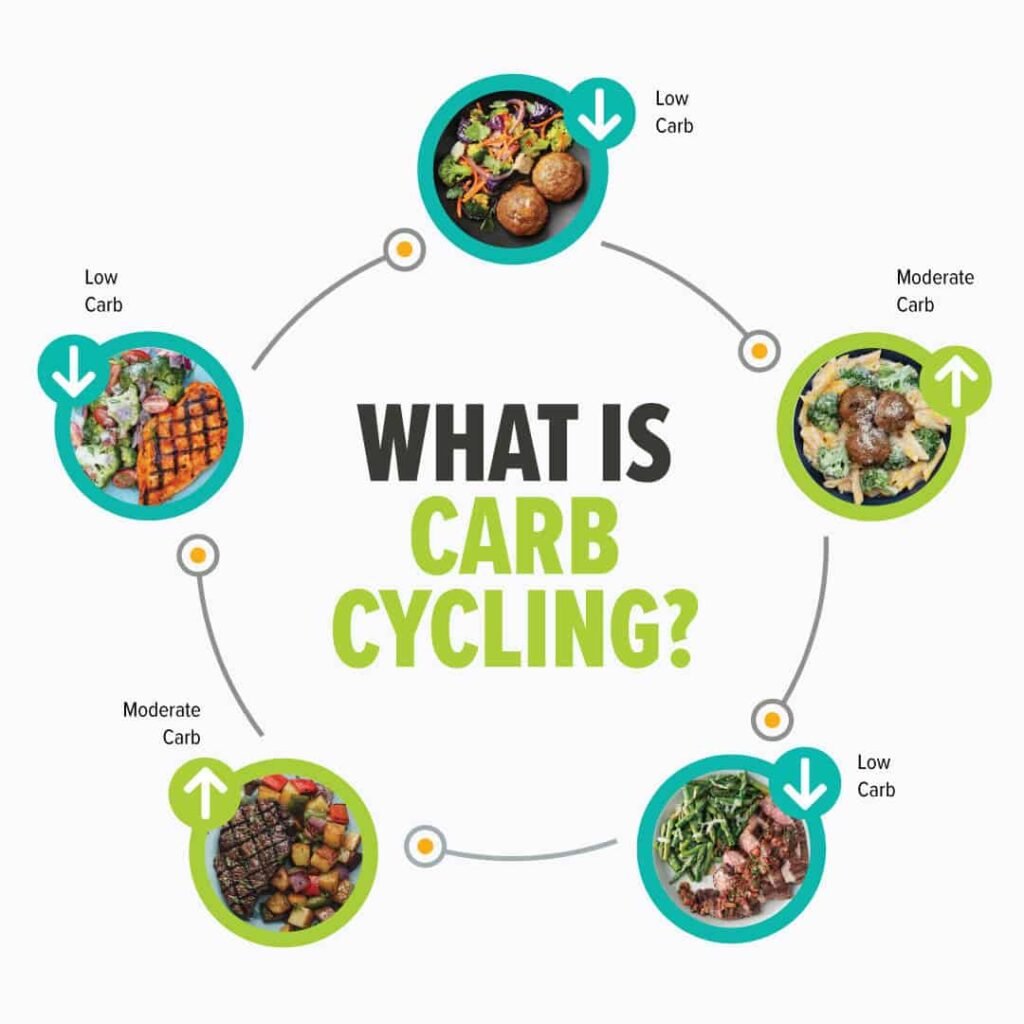Table of Contents
Introduction:
Many of us are trying to live healthier lives and reach our fitness goals in today’s fast-paced society. The carb cycling meal plan has become a well-liked and successful method to get us there. We can get better results and make the most of our body’s potential by carefully varying the kind of carbohydrates we consume.
Understanding Carb Cycling meal plan:

A nutritional strategy called “carb cycling” alternates between days when you consume more carbohydrates and days when you consume fewer carbohydrates. Our bodies are better fueled for intense exercise on days when we eat more carbohydrates, and the glycogen stores in our muscles are restored. Conversely, days with decreased carbohydrate intake urge the body to use fat reserves as a source of energy.
Health Benefits of Carb Cycling:
Beyond only helping you lose weight, carb cycling meal plans have many other advantages. Improved insulin sensitivity is one of the key benefits. We can control blood sugar levels and lower the chance of developing insulin resistance, which is linked to a number of health problems, by adjusting our carbohydrate consumption.
Additionally, by precisely timing our carbohydrate intake, we can increase both our daily energy and workout performance. This helps us workout more effectively and maintain an active lifestyle more successfully.
Carb cycling also supports muscle preservation. When we reduce carbohydrate intake, our bodies turn to fat as a primary fuel source. However, they also take measures to protect our muscle mass, ensuring that we maintain strength and lean muscle even during periods of calorie restriction.
Designing an Effective Carb Cycling Meal Plan:
It’s important to take into account your particular goals and needs while developing a carb cycling meal plan that works for you. Start by estimating your daily caloric requirements and figuring out the proper macronutrient distribution for each day.
On days when you consume a lot of carbohydrates, concentrate on consuming complex carbohydrates from foods like whole grains, fruits, and starchy vegetables. These will effectively feed your body and offer prolonged energy for strenuous workouts.
Prioritize lean proteins, healthy fats, and non-starchy veggies on low-carb days. These options will still give your body the nutrition it needs while encouraging it to use fat that has been stored as energy.
Find a balance between carbohydrates, proteins, and fats on maintenance days to boost your energy levels and prevent noticeable oscillations.
Sample Carb Cycling Meal Plan:
Here’s a sample carb cycling meal plan to give you an idea of how to structure your days:
High-Carb Day:
- Breakfast: Whole grain oatmeal with berries and a tablespoon of almond butter.
- Lunch: Grilled chicken breast, quinoa salad with mixed vegetables, and a side of sweet potato.
- Snack: Greek yogurt with sliced fruits.
- Dinner: Brown rice with stir-fried tofu and broccoli.
Low-Carb Day:
- Breakfast: Veggie omelet with spinach, bell peppers, and feta cheese.
- Lunch: Mixed greens salad with grilled salmon and avocado.
- Snack: Cottage cheese with cucumber slices.
- Dinner: Baked chicken with steamed asparagus and a side of cauliflower rice.
Maintenance Day:
- Breakfast: Whole grain toast with scrambled eggs and sliced avocado.
- Lunch: Turkey lettuce wraps with hummus and a side of carrot sticks.
- Snack: Nuts and dried fruits mix.
- Dinner: Grilled shrimp with quinoa and sautéed zucchini.
Tips for Success:
With a meal plan for carb cycling, consistency is crucial. In order to resist temptations to stray from the plan, prepare your meals in advance. Keep track of your development to maintain motivation and adapt as necessary based on how your body reacts. To keep your sanity and commitment to the program, remember to sometimes include some well-planned cheat meals.

Combining Carb Cycling with Exercise:
Pairing carb cycling with the right workout routine can enhance its benefits. On high-carb days, schedule your more intense workouts to take advantage of the increased energy. On low-carb days, opt for lighter activities like yoga or walking to avoid overtaxing your body.
Conclusion: Carb cycling is a flexible and effective approach to improve your health and fitness journey. By strategically adjusting your carbohydrate intake, you can optimize your body’s ability to burn fat, boost your energy levels, and support muscle preservation. Remember to listen to your body, be patient with yourself, and find a carb cycling plan that suits your unique needs. With dedication and consistency, you can enjoy the benefits of an effective carb cycling meal plan and pave the way to a healthier and fitter you.
Author:
Mike is a content marketer, young blogger and fitness freak. He likes to travel and write health and fitness related blogs.


Awsome blog! really helpful.
tips http://www.ve-online.com.